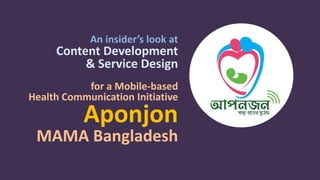Aponjon - Content & Service
- 1. An insider’s look at Content Development & Service Design for a Mobile-based Health Communication Initiative Aponjon MAMA Bangladesh
- 2. Let’s see some statistics
- 3. Everyday, 1,000 women die in child birth or in pregnancy 2 out of 5 Children die During the First Month of their Life
- 4. Children Die From Preventable Causes Under the Age of 5 29,000 Everyday 21Each Minute *315 children will die by the time I finish this presentation
- 5. On the other hand,
- 6. 3 out of 4 People Have access to Mobile Phones
- 7. 1 Billion Women in low & middle income countries own Mobile Phones
- 8. On May 3, 2011 Hillary Clinton Former Secretary of State Inaugurated MAMA
- 9. MAMA sends pregnant women & new mothers behavior change messages via mobile phone
- 11. The service was rebranded as Aponjon In Bangla it means Trusted Friend
- 12. Customization of this service for women in Bangladesh
- 13. 45% Women in Bangladesh Can’t Read Voice Message In Local 6 Dialects
- 14. Let’s listen to some messages
- 15. What voice/style Women Trust? A Lady Doctor Little bit of everything… Authoritative, Dramatized, Suggestional
- 16. A Lady Doctor Women seek information from the most learned person (in this case a Doctor) women feel shy with a male doctor women like stories they can relate to Though this is one way communication, Aponjon is allowing for ecological impacts like media and cultural context as Street (2003) suggested. Homophily Credibility Evaluation of health information Likelihood to act on advice They also tried to create the sense of homophily as suggested by Wang et al (2008), to increase likelihood of acting on advice
- 17. Different Areas have Different Vegetables Different Climate Messages suggesting Food & Clothes were Localized
- 18. As Freeman (2000) points out with the example of the different understanding of the word "Control" (Metabolic, compliance, & situational) between provider-patient, it is important to have an understanding of shared meaning of the messages. If the content directs a mother to a specific food or clothing item, which is not available or is called by a different name in her area the purpose of the communication fails. Also, as Airhihenbuwa & Liburd (2006) pointed out with example of lack of proper healthy food sources for African-American communities, it is important to identify localized nutrition sources in locally produced vegetables Understanding Local context & establishing shared meaning
- 19. Households have mobile phones Women Don’t Message for Gate Keepers Husband/Mother-in-law Flexible Timing
- 20. It is important to understand the power dynamics and level of access a women has in Bangladesh Husbands & Mother- in-laws influence decision making The gate keepers can contribute towards non-adherence to the messages if they felt the information is not trustworthy, Peek et al (2008) observed similar phenomenon with African American Women. Aponjon took the shared decision making concept of patient-provider communication (Charles et al, 1997) and tried using it between the authoritative gate-keepers and the mothers. They provided messages both parties so they can act towards a common goal.
- 21. women from conservative families or hard to reach areas Don’t Know about the Service Registration through Info-Ladies
- 22. Registering is difficult for most women who are technologically challenged 2 ways of Registration Info-Ladies & 24/7 Call Centers
- 23. Peer Advocates and Cultural Humility is key to recognition of benefits of the service & registration As Golden & Matsaganis (2013) found true with low income African American women, recruiting residents to become peer advocates work as catalysts. Aponjon recruits village women and train them to become "InfoLady“ For the call centers also, Aponjon recruited educated urban slum/ village girls. This resonates with Perloff et al’s (2006) finding that taking a person from another background and training them in cultural competence might not result into cultural humility
- 24. A large portion of our target are below poverty line* 28% in Urban 36%in Rural can they afford the service? Free Service for extreme poor disabled marginalized Reduced Price for women headed house special circumstances *Earning Below USD 1.25 Per Day
- 25. Recognizing Need & Patient Health Navigation Infoladies help women to get registered and also enable them to access subsidized care if the family qualifies for subsidy Infoladies work as navigators (Cohen et al (2013) by being bridge between resources, considering cultural understandings, and aiding in partner control tactics. Being from the same community they are sensitive to their patients’ spiritual sensitivities.
- 26. 1.3 million*women subscribe to the service today, *That’s 1.5 times the population of San Francisco
- 27. Questions?



























